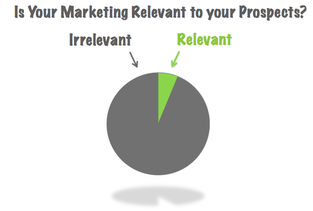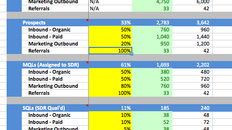
Sounds depressing, right? But if you compare your potential market opportunity to the number of active buying cycles your sales team will engage in this year, it becomes pretty clear that of the majority of people in the world that you could sell to, most won’t be sold to in the next year. This isn’t a knock on your marketing or sales prospecting effectiveness, even if you improved these by 100%, chances are it would only increase your annual market penetration a couple of percent.
So what is it that’s stopping all of these prospects from purchasing right now? Usually it’s factors largely out of your control such as your prospect’s budget, leadership, timing, and their other priorities. But what’s equally important to know is that all of these obstacles are usually temporary.
Which is why it’s so important to segment your content and offers by buying stage. If the majority of your prospects are “no stage” buyers, blasting out late stage offers like the opportunity to speak with a salesperson or watch a 30 minute product demo will drum up as many unsubscribes as clicks. And once someone unsubscribes, literally or mentally, your ability to market to them down the road is severely restricted.
So what’s a marketer to do in a world of “no-stage” buyers?
- Incorporate buying stage into your campaign & content planning - when planning marketing investments, identify the targeted buying stage and ensure your program and content portfolio covers the full funnel, from no stage buyers all the way through to closing.
- Listen for your prospects online activity - What pages prospects visit and what offers they respond to can help you identify when they have entered an active buying cycle, A.K.A. when it’s time to shift messaging to later stage topics.
- Use dynamic and reactive marketing tactics - seize the power of marketing automation and use dynamic content, multistage nurturing and other reactive marketing tactics that considers buying stage before serving up offers and content.
- Focus on aspirations, rather than features - people tend to evaluate features when they are in a buying cycle, but everyone wants to be more successful in their jobs, have happier customers, etc... Even in B2B, no stage and early stage marketing that focuses on emotion or personal topics will produce better results than a feature focus.
- Consider buying stage when setting the period between touches - an actively engaged prospect late in a sales cycle probably won’t mind receiving great content from you every couple of days. However early or no-stage buyers are much more likely to consider weekly emails spam.
- Measure your clicked to unsubscribed ratio - never forget that an unsubscribe is FOREVER! So it is important to factor in the lost opportunity associated with every unsubscribe. A simple ratio of: (number of clicks) / (number of unsubscribes), can quickly show you if you are turning as many people off as you are engaging with your email marketing.
- Add a punt to your lead qualification process - most lead qualification teams tend to think of the life in 7-30 day bursts. A lead comes in, they work it for a fixed period of time or until it is either an opp or disqualified, then they move on, possibly never to return. But because many reasons for disqualification can be temporary (too busy, no budget this quarter, current prioritization of projects), it’s important to set up systematic workflow that allows salespeople to recycle leads for a month, a quarter, or even a year. This way they can automatically be reminded (even in the event of territory changes) to reach back out when the timing is likely to be better.
- Set appropriate goals for no stage campaigns - because the majority of your no stage buyers are 12+ months away from purchase, tying them to opps and ROI is not possible if you are looking for real time success metrics. Instead, focus on tight demographic segmentation (are we engaging people and companies who could buy one day?) and activity metrics like unique web visitors, content downloads, etc…
So take a long term, more strategic view the next time you are planning or executing your campaigns and consider the “no stage” buyer. ‘
Happy marketing!
-Chris
Author: Chris Russell



 RSS Feed
RSS Feed